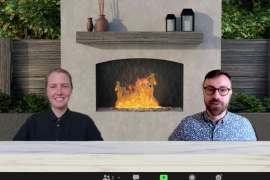How do you get the most out of videos in teaching? Arc is a new video platform that will allow you to do so much more with video content. As part of the transition to Canvas – the new learning management system to replace Blackboard – we’ve invested in a video platform called Arc. Arc is a new tool that integrates seamlessly with Canvas and provides powerful accessibility, collaboration and analytics capabilities. Our first staff to use Canvas for their units this semester have had very positive experiences using Arc.
“Arc makes video learning easier and more effective for teachers and students, and is a further investment in transforming the learning experience for our students,” said Professor Adam Bridgeman, Director of Educational Innovation in the Education Portfolio. “Now that it’s easy for everyone to produce simple videos on their phone or higher quality video in our DIY recording studio, the video medium has become an important teaching tool. Arc has some very cool analytics, which teachers will find useful. Importantly, Arc has great accessibility features, such as automated captioning, which means all of our students can use Arc videos.”
So what sets Arc apart? In addition to easy and fast video uploading and streaming for staff and students, the standout functions are:
Interactive video collaboration
Instead of video being a one-way transmissive medium, Arc gives students and staff the ability to post comments or questions on a video timeline in real time. Comments are pinned to specific moments within a video and pop up while the video plays, allowing threaded discussions. This way, students can benefit from each other’s questions and insights, as well as from their teachers’ feedback.
Easy video submission
Arc allows staff and students to upload many video and audio formats easily. This means students can easily submit videos privately to teachers as assignments, and markers can view videos alongside rubrics for efficient and meaningful grading and feedback. Students can even embed Arc videos directly into discussion posts and provide peer feedback.
Accessible content using automatic captioning
As students increasingly learn and interact with content online through videos, it is vital that our learning resources are accessible to all. Providing closed captions for video content is quick and easy with Arc. In Arc you can request computer-generated captions in a range of languages, with up to 90 percent accuracy. Editing auto-generated captions before publishing them is easy. This gives you the ability to make video content more accessible for all students, be it those with a hearing impairment, those working in a second language, those who may struggle with expression, or even those who cannot use audio temporarily. In addition, students can view the content at their own pace by slowing down or speeding up the video.
Improved analytics
Arc provides valuable data on how your students are engaging with videos at a cohort level and for individual students. You can quickly and easily access information about how students have engaged with videos, answering questions such as: Did they stop watching after a certain period? Which parts are watched more than others? This provides valuable information about how to refine media and communicate learning material more effectively.
Plus more
Overall, a recent evaluation told us staff prefer Arc for how easy it is to use, the ability to make videos into an interactive teaching and learning experience, and improved accessibility options. When the new Canvas quiz engine is available in early 2018, you will be able to embed a rich array of questions and feedback options within your Arc videos.
Find out more
If you would like to learn more about Arc and how to incorporate it into your online learning material, the Educational Innovation team is running Canvas skills workshops which include Arc.
The current video streaming tool, Kaltura, will still be used for Blackboard sites and will be decommissioned at the end of 2018 along with Blackboard.
This post has been reblogged with permission from Staff News.





